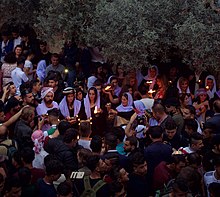یزدی مذہب
یزدیت [ا] ، متبادل طور پر شرفالدین [ب] [7] [8] [9] ایک توحیدی نسلی مذہب ہے [10] [11] [12] [13] جس کی جڑیں مغربی ایرانی قبل از زرتشت مذہب یا براہ راست ہند ایرانی روایت سے ماخوذ ہے۔ [14] اس کی پیروی بنیادی طور پر کرد بولنے والے یزدی کرتے ہیں اور یہ ایک خدا پر یقین پر مبنی ہے۔ یزدی مذہب میں خدا کا تصور تھوڑا مختلف ہے یعنی جس نے دنیا کو تخلیق کیا اور اسے سات مقدس وجودوں کے سپرد کیا، جسے فرشتے کہا جاتا ہے۔ [7] [15] ان فرشتوں میں سرفہرست طوسی ملک ہے (جس کی ہجے "ملک طاؤس" بھی ہے)، جو فرشتوں کا سردار ہے اور جسے دنیا پر اختیار حاصل ہے۔ [7] [16] [17]
 | |
| قسم | Ethnic religion |
|---|---|
| زمرہ بندی | Iranian religions[1][2] |
| صحیفہ | Yazidi Book of Revelation, Yazidi Black Book |
| الٰہیات | Monotheistic |
| Mir | Hazim Tahsin or Naif Dawud[3] |
| Baba Sheikh | Sheikh Ali Ilyas[4] |
| زبان | Kurdish (Kurmanji) |
| صدر دفاتر | Lalish, Iraq |
| ابتدا | 12th century Kurdistan |
| اراکین | ت 1,000,000–1,500,000 (Yazidis)[5][6] |
| دیگر نام | Sharfadin |
حوالہ جات
ترمیم- ↑ Christine Allison (20 ستمبر 2016) [20 July 2004]۔ "YAZIDIS i. GENERAL"۔ Encyclopædia Iranica۔ New York: Columbia University۔ DOI:10.1163/2330-4804_EIRO_COM_1252۔ ISSN:2330-4804۔ 2016-11-17 کو اصل سے آرکائیو کیا گیا۔ اخذ شدہ بتاریخ 2022-01-09
- ↑
- ↑ "Yezidis divided on spiritual leader's successor elect rival Mir"
- ↑ "The Yazidis are still struggling to survive"۔ The Economist۔ 10 دسمبر 2020۔ ISSN:0013-0613۔ اخذ شدہ بتاریخ 2021-01-08
- ↑ Christina Lamb (22 ستمبر 2020). Our Bodies, Their Battlefields: War Through the Lives of Women (انگریزی میں). Simon and Schuster. p. 24. ISBN:978-1-5011-9917-2.
- ↑ "Aziz Tamoyan blames unknown forces for crippling history and culture of Yazidis". armenpress.am (انگریزی میں). Retrieved 2021-01-10.
- ^ ا ب پ Garnik S. Asatrian؛ Victoria Arakelova (2014)۔ "Part I: The One God - Malak-Tāwūs: The Leader of the Triad"۔ The Religion of the Peacock Angel: The Yezidis and Their Spirit World۔ Gnostica۔ Abingdon, Oxfordshire: Routledge۔ ص 1–28۔ DOI:10.4324/9781315728896۔ ISBN:978-1-84465-761-2۔ OCLC:931029996
- ↑ Artur Rodziewicz (2018)۔ "The Nation of the Sur: The Yezidi Identity Between Modern and Ancient Myth"۔ در Joanna Bocheńska (مدیر)۔ Rediscovering Kurdistan's Cultures and Identities۔ Cham: Palgrave Macmillan۔ ص 272۔ DOI:10.1007/978-3-319-93088-6_7۔ ISBN:978-0-415-07265-6
- ↑ Omarkhali, Khanna (2017)۔ The Yezidi religious textual tradition, from oral to written : categories, transmission, scripturalisation, and canonisation of the Yezidi oral religious texts: with samples of oral and written religious texts and with audio and video samples on CD-ROM۔ Harrassowitz Verlag۔ ISBN:978-3-447-10856-0۔ OCLC:994778968
- ↑ Preti Taneja (2007). Assimilation, Exodus, Eradication: Iraq's Minority Communities Since 2003 (انگریزی میں). Minority Rights Group International. p. 13. ISBN:978-1-904584-60-5.
- ↑ Chris Chapman; Preti Taneja (2009). Uncertain Refuge, Dangerous Return: Iraq's Uprooted Minorities (انگریزی میں). Minority Rights Group International. p. 8. ISBN:978-1-904584-90-2.
- ↑ Samer Muscati; Human Rights Watch (Organization) (2009). On Vulnerable Ground: Violence Against Minority Communities in Nineveh Province's Disputed Territories (انگریزی میں). Human Rights Watch. p. 18. ISBN:978-1-56432-552-5.
- ↑ David Sorenson (3 اکتوبر 2018). An Introduction to the Modern Middle East, Student Economy Edition: History, Religion, Political Economy, Politics (انگریزی میں). Routledge. p. 82. ISBN:978-0-429-96271-4.
- ↑ (1) Turgut, Lokman۔ Ancient rites and old religions in Kurdistan۔ OCLC:879288867
- ↑ Birgül Açikyildiz (23 دسمبر 2014). The Yezidis: The History of a Community, Culture and Religion (انگریزی میں). I.B.Tauris. ISBN:9780857720610.
- ↑
- ↑ Sebastian Maisel (24 دسمبر 2016). Yezidis in Syria: Identity Building among a Double Minority (انگریزی میں). Lexington Books. ISBN:9780739177754.